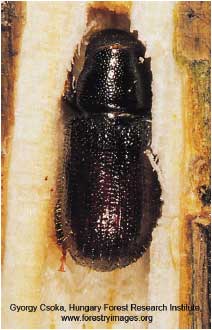
Pine Shoot Beetle
ID
444-291
Order: Coleoptera
Family: Scolytidae
Species: Tomicus piniperda (Linnaeus)
Size: The adults are 1/8 to 1/4 inch long. The larvae are legless and can be up to 1/4 inch long.
Color: Pine shoot beetles are dark brown. The larvae have a dark brown head and creamy white body.
Description: Pine shoot beetles are in the same family as bark beetles and resemble bark beetles in appearance with their cylindrical shape.

Habitat: The pine shoot beetle is native to Europe, but it is now found in the United States from Illinois to Vermont and south to Virginia. It is thought to have come to the United States with wood pallets, dunnage, and shipping containers arriving on ships coming into the Great Lakes. It was first recorded in Ohio in 1992 and was quickly found in other states bordering the Great Lakes.
Life Cycle: Adults overwinter on the bark of pine trees. The beetles exit the overwintering site and begin flying about when the temperature reaches or exceeds 54°F. The first flight usually takes place in late winter or early spring. Adults lay eggs on stumps, logs, and dying Scotch and related pines. The larvae feed under the bark and make galleries 3 to 10 inches long. The immature stage usually lasts from April until June. The larvae pupate under the bark and the adults emerge throughout the summer. Adults can fly several miles in search of new hosts and there is one generation per year.
Type of Damage: They feed on white and Scotch pine. The newly emerged beetles damage live shoots of white pine in the summer; this is called "maturation feeding" as they are not laying eggs at this time. During maturation feeding the beetle makes clean tunnels inside small live shoots. The damaged shoots turn yellow, then brown and are easily contrasted against the remaining green foliage.
Control Methods
Chemical: Chemical control is usually not necessary.Non-chemical: Removing dead and dying Scotch pine will remove breeding sites and reduce the attractiveness of plantations to beetles that might be in their vicinity. This beetle is not likely to become a problem on yard trees.
Quarantine
By law, all counties that have records for pine shoot beetles must be under quarantine. The quarantine requires that all commercial growers of Christmas trees to be under a compliance agreement with the Virginia Department of Agriculture and Consumer Services (VDACS).It requires:
- All dead and dying trees to be removed from the Christmas tree farm. These potential brood trees must be burned, chipped, or buried under at least 12 inches of soil.
- Cut stumps flush (within 1 inch) to the ground during or just after harvest. Spray the exposed surface of stumps with an approved insecticide as listed in the Pest Management Guide just before flight of overwintering beetles, January to mid-February, depending on the location. (This is the same timing and method used to treat pales weevil.)
- Pine species must be visually scouted for infested shoots between July and October. Infested shoots, if found, must be removed and destroyed by burning or burying.
- Pine logs must be used as trap or sentinel logs. Logs must be in place by January and checked once the daytime temperature exceeds 50°F. Logs must be removed between April 1 and April 20 by burning or burying.
- Trees only need to be chemically treated if the pine shoot beetle is found on the farm or within 1/2 mile.
- Pertinent records include the number of trees scouted, scouting dates, sanitation treatments conducted, trap log activities, and insecticide usage. A sample form will be provided for use.
- VDACS nursery inspectors will work with growers in infested counties to clarify any questions about the compliance agreement. In Virginia call (757) 786-3515 to arrange to have a nursery inspector visit your farm.
Rights
Virginia Cooperative Extension materials are available for public use, re-print, or citation without further permission, provided the use includes credit to the author and to Virginia Cooperative Extension, Virginia Tech, and Virginia State University.
Publisher
Issued in furtherance of Cooperative Extension work, Virginia Polytechnic Institute and State University, Virginia State University, and the U.S. Department of Agriculture cooperating. Alan L. Grant, Dean, College of Agriculture and Life Sciences; Edwin J. Jones, Director, Virginia Cooperative Extension, Virginia Tech, Blacksburg; Jewel E. Hairston, Interim Administrator,1890 Extension Program, Virginia State, Petersburg.
Date
May 1, 2009